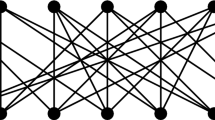Abstract
There are infinite sequences of graphs {G n } where |G n | = n such that the minimal dominating sets for G i × H fall into predictable patterns, in light of which γ (G n × H) may be nearly linear in n; the coefficient of linearity may be regarded as the average density of the dominating set in the H-fibers of the product. The specific cases where the sequence {G n } consists of cycles or path is explored in detail, and the domination density of the Grötzsch graph is calculated. For several other sequences {G n }, the limit of this density can be seen to exist; in other cases the ratio \({\frac{\gamma (G_n \times H)}{\gamma (G_n)}}\) proves to be of greater interest, and also exists for several families of graphs.
Similar content being viewed by others
References
Bayati, M., Gamarnik, D., Tetali, P.: Combinatorial approach to the interpolation method and scaling limits in sparse random graphs. In: STOC’10—Proceedings of the 2010 ACM International Symposium on Theory of Computing, pp. 105–114. ACM, New York (2010)
Chang T.Y., Clark W.E., Hare E.O.: Domination numbers of complete grid graphs. I. Ars Combin. 38, 97–111 (1994)
Fisher D.C., McKenna P.A., Boyer E.D.: Hamiltonicity, diameter, domination, packing, and biclique partitions of Mycielski’s graphs. Discrete Appl. Math. 84(1–3), 93–105 (1998). doi:10.1016/S0166-218X(97)00126-1
Golay M.J.E.: Notes on digital coding. Proceedings of the IRE 37(6), 657 (1949). doi:10.1109/JRPROC.1949.233620
Jacobson M.S., Kinch L.F.: On the domination number of products of graphs. I. Ars Combin. 18, 33–44 (1984)
Jacobson M.S., Kinch L.F.: On the domination of the products of graphs. II. Trees. J. Graph Theory 10(1), 97–106 (1986). doi:10.1002/jgt.3190100112
King E.L.C., Pelsmajer M.J.: Dominating sets in plane triangulations. Discrete Math. 310(17–18), 2221–2230 (2010). doi:10.1016/j.disc.2010.03.022
Liu H., Pelsmajer M.J.: Dominating sets in triangulations on surfaces. Ars Math. Contemp. 4(1), 177–204 (2011)
Molloy M., Reed B.: Graph Colouring and the Probabilistic Method. Springer, Berlin (2002)
Rubalcaba, R., Slater, P.J.: Efficient cartesian product layer domination. In: 22nd Cumberland Conference on Combinatorics, Graph Theory and Computing (2009)
Vizing V.G.: Some unsolved problems in graph theory. Uspehi Mat. Nauk 23(6 (144), 117–134 (1968)
Author information
Authors and Affiliations
Corresponding author
Rights and permissions
About this article
Cite this article
Brauch, T., Horn, P., Jobson, A. et al. Stack Domination Density. Graphs and Combinatorics 29, 1689–1711 (2013). https://doi.org/10.1007/s00373-012-1219-2
Received:
Revised:
Published:
Issue Date:
DOI: https://doi.org/10.1007/s00373-012-1219-2




